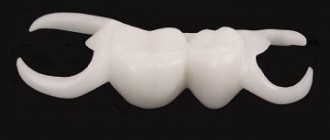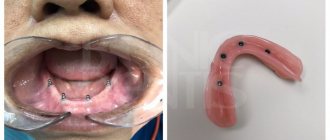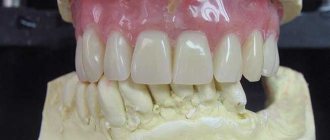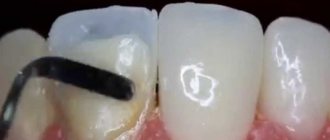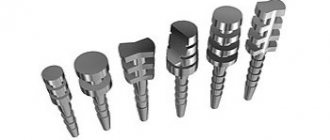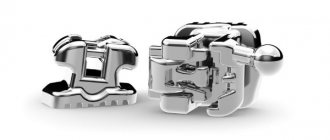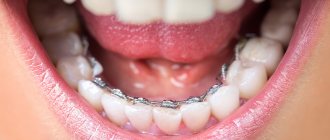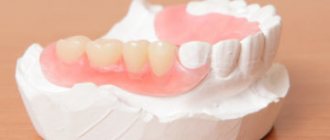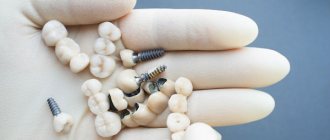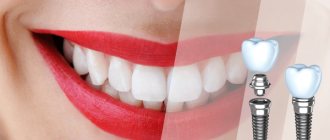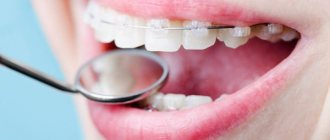Losing a tooth can bring a lot of troubles to a person: it becomes inconvenient to eat, the jawbone atrophies (decreases). And if a tooth is missing in the front part of the dentition, then aesthetic problems are added to all these problems, because no one wants to show emptiness when talking and smiling.
Dental implantation with further prosthetics can save the patient from inconvenience, and modern technologies make it possible to do this as quickly as possible. The main thing is not to delay contacting the clinic and choose a qualified doctor, because implantation of the front teeth has its own characteristics and subtleties.
Get a consultation
We will answer all your questions before visiting the clinic!
+7
Online registration
Content
hide
1 What are the subtleties of implantation of anterior teeth?
2 Which implants are best placed on the front teeth?
3 Which crown for a front tooth implant should you prefer?
4 Photos before and after implantation of anterior teeth
5 How to avoid aesthetic defects when implanting upper anterior teeth?
6 Is osteoplasty necessary before implantation of anterior teeth?
7 Stages of implantation of anterior teeth 7.1 Diagnosis and planning
7.2 Implant installation
7.3 Fixation of crowns
8 Possible complications and rehabilitation after implantation of anterior teeth
9 Choosing the shade of the crown during subsequent whitening
10 Care for implants on front teeth
11 Prices for implantation of front teeth
12 Reviews about implantation of front teeth
Installation steps
The technology for installing a crown on an implant depends on its material and the protocol used. As an example, let us consider in general the process of manufacturing and installing a zirconium oxide crown in the frontal zone using 3D modeling and CAD-CAM technology:
- Scanning with a special camera the implant with abutment and antagonist teeth.
- Construction of a three-dimensional model using a special program based on scanning data.
- Turning the crown frame from a monolithic piece of sintered zirconium oxide blank. The work is performed on a program-controlled milling machine connected to a computer.
- Firing the zirconium frame in a kiln to give it ultimate strength.
- Layer-by-layer application of ceramic mass to the frame with firing after each applied layer.
- Application and firing of the coloring layer.
- Fitting the crown to the abutment and, if necessary, modifying it.
- Installation of the structure using cement or a threaded connection on the abutment. In the first case, fixation is performed in the oral cavity, in the second - outside it, followed by fastening the structure to the implant.
What are the subtleties of implanting anterior teeth?
The need to reconstruct teeth in the frontal region may arise in patients of different age categories, which is due to the variety of factors that caused the appearance of the defect. First of all, this is due to injury to the jaw, the unprofessional approach of the dentist, or the presence of massive carious lesions.
If the loss of teeth located in the chewing zone does not require immediate consultation with a specialist, then the loss of teeth in the anterior section forces the patient to urgently visit the dentist.
In this case implantation of anterior teeth is most often performed with the aim of restoring aesthetic perfection. Therefore, installation of dental structures in this area must be carried out by a specialist of the highest level, who has special professional skills and ensures maximum accuracy of the procedures performed.
Implantmaster dentistry employs qualified doctors who take their specialty seriously and regularly improve the level of their professional training. Moreover, they are fluent in modern methods of fixing implants, namely, they carry out simultaneous implantation of front teeth , with instant loading. This allows you to install an implant immediately after tooth extraction and at the same time fix a temporary crown. By providing instant loading, we are able to not only recreate lost teeth, but also form the correct gingival contour.
You may also be interested in:
Patient reviews. Works of doctors Video about the clinic
Sign up for a consultation
three ROOTT specialists + diagnostics as a gift
All specialists Our specialists
Unable to install a standard dental implant, ROOT Center specialists practice mini-implantation - fixing removable dentures with reliable and invisible titanium fasteners.
0:45
Omerelli Emir Romanovich
maxillofacial surgeon-implantologist and candidate of medical sciences
0:45
Pak Roman Vladimirovich
orthopedic dentist
0:45
What implants are best for front teeth?
The best option for the frontal area is to fix structures with a small diameter. To obtain excellent aesthetic parameters in the gum area and eliminate the need for augmentation, such implants must be installed just below the bone line.
If we talk about the manufacturer of dental systems, it is better to focus on large and well-known companies, so that in unforeseen situations you can find a suitable material to replace the crown. In addition, many manufacturers make significant errors in the production of their implantation systems, which can lead to serious complications in the future, including peri-implantitis.
In our activities we use premium quality structures (Straumann, Osstem), from trusted manufacturers. Moreover, thanks to direct cooperation with them, every visitor can count on loyal prices and a lifetime guarantee.
Rating of dental implants »
Full implantation
In case of complete absence of teeth in conditions of weak or moderate atrophy, the all-on-4 protocol is used. In case of severe deficiency, the all-on-6 technique is allowed. The doctor fixes the implants according to preliminary calculations with minimal trauma to the soft tissues (by puncture). Dentures are installed after 2-3 hours or on 2-3 days.
It is possible to use classical implantation, but this technology is not justified for the entire dentition, since it requires the installation of implants in place of each tooth. In addition, usually with complete edentia, bone tissue atrophy is observed. The classic protocol is not applicable in such conditions; additional sinus lift surgery will be required.
Some clinics offer complex basal implantation - specially shaped implants are installed in the deep layers of the jawbone. The method has not been confirmed by clinical trials and is not used in our dentistry.
Implantation of anterior, chewing teeth and full upper jaw
Which crown for a front tooth implant should you prefer?
For the production of prostheses for anterior dental implants , metal-free ceramics are most often used. It is also possible to use zirconium aluminum oxide material, which allows you to obtain aesthetic and natural crowns with a long service life.
The advantages of such prosthetic devices when implanting anterior teeth are obvious:
- Implants for the front teeth , made from the above materials, are famous for their exceptional strength and are lightweight, which will minimize pressure on the gum tissue;
- Full compatibility with the human body, absence of allergic manifestations;
- When using ceramic material, the possibility of receding gum tissue is eliminated;
- Ceramics and dental tissues have identical parameters: they have the same light transmittance, color fastness, refraction and increased thermal conductivity.
However, the most advantageous option for crowns when implants are fixed on the front teeth is considered to be the innovative glass-ceramic material e.max. It has perfect functional and aesthetic characteristics and is famous for its excellent quality and versatility. Also, the advantages of using emax include:
- Maximum strength indicators (500 MPa). Achieved through the use of the latest technical solutions and materials of unsurpassed quality;
- Wide scope of application. Metal-free glass ceramics e.max can be used to reproduce lost units both in the masticatory region and in the anterior region;
- Impeccable aesthetic indicators. Thanks to the introduction of a unique manufacturing technology, specialists now have the chance to choose the shade of the crown with maximum accuracy. Dentists also had the opportunity to adjust the degree of transparency of the material, which fully corresponds to natural teeth;
- Long period of operation. Crowns made according to the e.max concept can be used for more than 15 years, which significantly exceeds the service life of prostheses made from any other materials;
- Absolute biocompatibility. The patient has no allergic reactions to this material.
Read more about the types of implant crowns »
Fixation methods
To attach the prosthetic structure to the implant, special elements called an abutment are used. They are usually supplied complete with implants with which they are supposed to be installed.
But they can also be made individually in the clinic’s laboratory. This is advisable if there is some clinical feature that makes the use of a standard or branded product undesirable.
Abutments have different designs. In most cases, their shape resembles a truncated cone; in other cases, they look like a sphere or other figure.
Abutments can be made integral with the implant. In other cases, they are connected to it using a threaded connection, for which they have a thread in the upper part for attaching the crown. The connection between the crown and the abutment can be permanent (using cement) or detachable (screwed).
The advantages of permanent connections include the technological simplicity of fastening, as well as the absence of the need for precise execution of the abutment, especially if it serves as a support in a bridge. And the cost of an abutment without fastening accessories is less.
The disadvantage of cement fastening is the inability to disassemble the superstructure if repair of any of its elements is required. The advantage is that there is no requirement for increased accuracy, since cement is able to compensate for some manufacturing inaccuracy.
In contrast to a permanent connection, a threaded fastening allows you to easily disassemble the structure and repair or replace a failed element.
The connection to the abutment is made outside the oral cavity. To insert a fixing screw through the crown into the abutment, a hole is made in it, which is sealed after installing the screw.
If for any reason it becomes necessary to detach the crown from the abutment, the seal covering the fastener is drilled out to access the screw.
The ability to disassemble is the most significant advantage of collapsible structures. Their disadvantages include increased complexity, the need for precise execution and a relatively high price.
The trend is that cement fixation is being used less and less. Dentists prefer screw fastening as it is more technologically advanced and advanced.
In the video, the doctor will talk in more detail about the methods of fixing crowns to an implant.
How to avoid aesthetic defects when implanting upper anterior teeth?
When an implant is fixed to the upper front teeth, the possibility of one-stage installation of a prosthetic device is present, but not in all situations. To exclude an aesthetic defect, a temporary crown can be used, which is attached to nearby units and does not cause damage to the gingival tissue. Despite the insufficient aesthetic parameters, it is quite possible to reproduce missing teeth using it. Moreover, the fixation of such an orthopedic system is carried out for a short period of time (about 3 months, 3-5 weeks with Straumann SLActive implants), after which the prosthesis is successfully replaced with a permanent type structure.
How is it carried out?
Implantation of the anterior upper and lower teeth consists of three stages: preparatory surgical and orthopedic stages. The entire procedure can take from several hours to six months, depending on the urgency of the operation and the condition of the teeth and oral cavity.
Preparatory stage
This stage includes a complete examination of the patient’s oral cavity and further planning of the surgical stage.
At the preparatory stage the following actions are carried out:
- the dentist takes a panoramic photo of the jaw, which can identify possible problems;
- if oral diseases are detected, they are treated;
- remove damaged front incisors;
- gum treatment;
- a suitable front tooth implant is selected;
- if necessary, bone tissue is increased (if there is not enough of it at the implantation site or it is damaged);
- making a pin;
- replacement of worn or damaged dentures or crowns (at the patient’s request) is carried out.
Surgical stage - installation of a titanium root
- Depending on the indications of the examination and the wishes of the patient, either local anesthetic or anesthesia is used before installing anterior dental implants.
- The dentist uses a scalpel or laser to make an incision in the gum , and then uses a surgical drill to make a hole.
- It places an implant on the front tooth.
- If the operation is not one-stage, the gum tissue is sutured.
All manipulations take no more than an hour.
Orthopedic
This stage of the procedure includes all the steps that follow the surgery: installing the abutment and crown, prescribing medications and instructions for caring for the implant.
At first, an implant on the front tooth requires special attention; it must take root and the tissues must grow together. Because of this, the patient may experience discomfort for some time, which usually goes away after 3-5 days. Complete engraftment takes about 20 days.
The need for bone grafting
Bone grafting is the augmentation of missing bone tissue; after completion of the procedure, you can install an implant without any problems, which will be fixed more reliably.
Various bone diseases can lead to the fact that the bone tissue at the implantation site does not have the necessary properties for reliable fixation of the implant. Also, a long absence of the front incisor at the implantation site can naturally lead to gradual tissue atrophy.
The need for this procedure can be advised by the dentist after a thorough medical history and panoramic X-ray examination. To carry it out, synthetic materials, bone tissue of the patient himself or animals can be used.
The placement of an anterior implant after bone grafting depends on the rate of tissue regeneration.
Implant placement methods
There are implantation methods using one-stage and two-stage technology.
One-step method:
- an incision is made in the gum;
- drilling a hole for the pin;
- its installation;
- installation of abutment;
- suturing the gum tissue around the abutment;
- installation of a temporary crown.
The permanent crown is installed after a few months.
Two-step method:
- the front gum is cut , a hole is made for the pin, then it is screwed in and the tissue is completely sutured;
- after the gum has healed, it is cut again and a former is installed; after a few weeks, an abutment is placed and a crown is attached to it.
Between the two stages it takes from several months to six months. At this time, you should not put too much pressure on the front gums. The main feature is the complete isolation of the implant, which allows bone tissue to fuse without much difficulty and increases the survival rate of the implant.
But you will have to be patient for some time, since the crown can be installed no earlier than in 3-4 months.
As a result of the above, patients more often resort to a one-stage method of implantation. But in any case, the patient chooses which dental implantation to do.
Is osteoplasty necessary before implantation of anterior teeth?
Unfortunately, bone tissue resorption is a common occurrence in the frontal region. This applies to situations where the tooth has been removed for a long time. To perform implantation of the lower anterior incisors in this case, bone material is simultaneously grafted. If implants are fixed on the upper front teeth, a procedure is performed to lift the lower part of the maxillary cavity (sinus lift). This makes it possible to save the patient’s effort and time, and also helps maintain the shape of the gum tissue and achieve the desired aesthetic effect.
Features of upper teeth implantation
During the chewing process, the upper jaw is subject to much less stress than the lower jaw, so its bone tissue has less density and atrophies faster in the event of tooth loss. The lateral sections of the upper jaw are most susceptible to the atrophic process. In addition, the maxillary sinuses are located nearby, which can also complicate dental implantation due to the presence of chronic diseases (sinusitis, sinusitis, etc.).
To solve these problems, preliminary osteoplastic surgery is used - sinus lift, aimed at replenishing the volume of bone tissue necessary for installing implants. If you have ENT diseases, it is also necessary to treat them before implantation in order to avoid possible serious complications.
Another problem may be the aesthetic features of prosthetics supported by upper jaw implants. This is especially true for the smile area, since there is a certain difficulty in forming the gum contour and accurately setting the implant axis, which is very important for successful prosthetics. To solve the first problem, one-stage implantation can be used, and to determine the correct location of the implants, computed tomography, preliminary modeling and surgical templates are used, which allow the implant to be positioned with maximum accuracy during surgery.
Stages of anterior teeth implantation
Next, we will tell you how to place implants on the front teeth .
Diagnostics and planning
The implementation of this stage is a prerequisite for planning further treatment measures. As part of it, a study of the patient’s body condition is carried out. Besides:
- The moral and physical preparation of the patient for the operation is provided;
- A computed tomography scan is performed to identify possible contraindications and future planning of the operation.
- The necessary treatment procedures are performed, including extraction of damaged teeth, elimination of carious lesions and inflammatory processes in the area of periodontal tissue and installation of filling material;
- If severe pathological processes are detected, measures to strengthen the tooth roots are mandatory;
- When there is significant loss of bone tissue, osteoplastic procedures are performed;
- If defects are detected on previously installed prostheses, they are replaced with new designs. In this case, the compatibility of materials is taken into account.
Implant installation
A mandatory procedure before surgery is the use of anesthetic drugs or general anesthesia. Typically, the effects of painkillers last about 90 minutes. Also at the stage of surgery:
- The implants are fixed in the area of the front teeth on the upper jaw ;
- The duration of the procedure can reach 30-50 minutes;
- The adapter is secured using the classic method;
- The intervention is minimally invasive.
Implantation of the lower anterior tooth , as well as fixation of dental structures in the maxillary region, can be performed using the following technologies:
- Simultaneous dental implantation with immediate load . This method involves implanting a tooth immediately after extraction and then installing a temporary crown to preserve aesthetics. A permanent crown (we recommend Emax glass ceramics) is installed after 3 months (3-5 weeks with Strauman implants).
- Classic two-stage dental implantation . It is performed if the tooth has been missing for a long period of time. The gum former is fixed to the installed implant and sutures are applied. And only after 3 months (3-5 weeks when installing Straumann) a permanent crown is installed.
The highest priority method is simultaneous dental implantation with immediate loading. It provides the following benefits:
- Allows you to quickly eliminate psychological discomfort associated with the presence of defects in the frontal region;
- Aesthetics. A temporary prosthesis is installed immediately after dental implantation;
- Resumption of eating is allowed several hours after the procedure.
Fixation of crowns
This is the final stage of the procedure. It involves installing an orthopedic temporary prosthesis, bridge or crown. Of all the above steps, surgical intervention plays a key role, because the operational life of the implant depends on the correctness of its implementation.
Stages of the procedure
Sanitation is mandatory before prosthetics.
Preliminary steps:
- a complete dental examination is carried out;
- teeth with caries are treated, canals are filled, fillings are placed;
- worn crowns and dentures are replaced;
- problems with the mucous membrane are eliminated, for example, periodontal disease and stomatitis;
- teeth that cannot be treated are removed.
Bone grafting is performed when an atrophic process occurs at the site of insertion of the prosthesis.
The need to build up bone tissue can be caused by repeated prosthetics, when the patient has had a bridge for a long time that does not provide load, or by tooth extraction from 0.5 to 1 year ago. The longer the period from the moment of tooth loss to the start of installation, the more difficult the operation will be.
Implantation steps:
- anesthesia is performed, anesthesia can be general or local depending on the complexity of the operation and the sensitivity of the patient, lasts 2 hours;
- the gingival flap is rejected;
- the implant is embedded into the bone, no additional actions are required, since the thread is self-tapping;
- an abutment is installed;
- the gingival flap is closed and sutures are applied;
- a temporary crown is installed;
- the crown is replaced with a permanent prosthesis after the implant has taken root.
With laser technology, there is no work with the gum flap.
Benefits of the laser procedure
Laser treatment is an alternative to scalpel treatment, which is now rarely used . The laser speeds up the process and reduces the area of the gum where the intervention will occur. Other advantages:
- the operation is quick;
- soft tissues are not only cut, but also sealed;
- bloodless method;
- the rays disinfect the site of exposure, the likelihood of an inflammatory process is minimal;
- a film is formed that protects the wound;
- gentle treatment;
- quick return to normal life.
Basal implantation
A modern technique that allows the installation of artificial incisors without bone tissue augmentation. Implants are placed where there is dense bone - in the basal layer , which is not subject to atrophic changes. The prosthesis is not implanted into the upper alveolar part of the jaw, but into the lower one.
The technology allows you to restore teeth in just a few days. Artificial teeth are implanted tightly and securely. The operation is performed immediately after the removal of diseased, damaged and loose teeth.
The method is suitable for patients with inflammation of the gums and periodontal tissues.
Possible complications and rehabilitation after implantation of anterior teeth
If the front tooth implant was installed in a little-known clinic in Moscow and by incompetent specialists, undesirable consequences may occur after the procedure. Among the most common manifestations, pain occupies a special place. Complications also include:
- The occurrence of swelling;
- The appearance of bruises;
- Temperature increase;
- Bleeding;
- The appearance of inflammatory foci;
- Seams coming apart;
- The appearance of an acute reaction to thermal stimuli.
Factors that provoke the occurrence of inflammatory processes include improper daily cleaning of the oral cavity or bone bed. In some situations, rejection of the installed dental structure may occur, the causes of which are inflammation or burns of bone tissue.
In order to prevent such negative manifestations, you should strictly adhere to the advice of a specialist. In the first hours after the implants of the upper front teeth are fixed, it is recommended to apply ice to the sore spot. This will prevent bleeding and swelling. After about 3 hours, soft foods are allowed. In addition, experts recommend regular rinsing of the mouth with an antiseptic.
Moreover, when an implant is installed on a front tooth, as reviews indicate, at first it is advisable to avoid pressure on the intervention area and also try not to sneeze. To eliminate pain, you can take an analgesic. 73 hours after fixation of the dental system, swelling should subside. If unpleasant symptoms persist, be sure to visit your doctor.
Metal-ceramic crowns
A metal-ceramic crown installed on an artificial titanium root is not much different from a metal-ceramic crown that is fixed on a natural tooth.
The differences lie in the possible type of fixation of the crown on the implant (read below about the method of transocclusal fixation) and in the more complex process of taking impressions and manufacturing. Metal-ceramic structures are fixed to the implant through metal abutments. After the abutment is installed, the orthopedic dentist takes silicone impressions from the teeth and sends it to the dental laboratory, where crowns for the implants will be made from the impression.
Advantages of metal-ceramic dental structures:
- They can withstand significant chewing loads, therefore they are most often used to restore chewing teeth;
- A properly manufactured prosthesis does not have a pathogenic effect on the oral mucosa;
- Acceptable aesthetic indicators;
- In case of minor damage, the crown must be restored.
Selecting a crown shade for subsequent whitening
So, when implants are fixed on the 4 front teeth or dental structures are installed in the anterior region of the mandibular region, the patient is initially assigned a temporary prosthetic device, and later a permanent crown. Therefore, he has some time to perform the bleaching and then choose the appropriate color of the orthopedic system. Subsequently, the prosthesis is manufactured, giving preference to a lighter enamel tone.
How are dental implants placed in the upper jaw?
The most common technique is classical implantation, which is carried out in several stages:
- During the surgical operation, the intraosseous part of the implant is installed in place of the missing tooth under local anesthesia.
- The period of engraftment (osseointegration) of implants takes place within 4–6 months.
- Installation of the supragingival part of the implant - an abutment, which will subsequently serve as a support for the orthopedic structure.
- Direct production and subsequent fixation of the denture
In some cases, a one-stage implantation technique can also be used, which involves installing a temporary crown on the implant immediately after the implantation surgery. This method is usually used for dental defects in the smile area to quickly rid the patient of an aesthetic defect. At the ARTOX clinic, partial and complete implantation of teeth in the upper jaw is carried out at low prices and with payment in installments.
Prices for implantation of front teeth
| Implant Osstem (South Korea) PROMOTION 20% discount | 28 000 22 500 ₽ |
| Implant Straumann SLA (Switzerland) PROMOTION 30% discount | 55 500 39 000 ₽ |
| Implant Straumann SLActive (Switzerland) PROMOTION 30% discount | 63 000 44 000 ₽ |
| Dentium implant (South Korea) | 35 000 ₽ |
| Anthogyr implant (France) | 40 000 ₽ |
| Implant Astra tech (Sweden) | 50 000 ₽ |
| Implant Nobel Biocare (Sweden) | 55 000 ₽ |
INSTALLING THE GINGIVAL FORMER
| 5 000 ₽ |
| Complete list of prices for dental implants » |
Prices for dental implantation on a turnkey basis »
For maximum aesthetics and durability, we recommend:
Simple tooth extraction (5,000 ₽) + Straumann SLAcitve implant (44,000 ₽) + Temporary crown (5,000 ₽) + e.max crown (37,500) = 101,000 ₽ (premium front tooth implantation on a turnkey basis).
Of course, you can install a more budget option:
Simple tooth extraction + Osstem implant + Temporary crown + metal-ceramic crown = 65,000 ₽.
When planning to install an anterior tooth implant , the price of the procedure may include several components: specialist services, the use of innovative equipment, the cost of materials, rent, tax contributions, etc.
In addition, when fixing a front tooth implant, the price by the cost of a crown or bridge, which is considered quite impressive. Dental systems from Swiss and American manufacturers are recognized as the most expensive. More budget designs are made by companies from Israel and South Korea.
Also, the cost of an implant is largely determined by the material from which it is made.
Features of the upper jaw and difficulties when installing implants
Difficulties in implantation in the upper jaw are associated with the loose porous structure of the bone due to lower chewing load. Features of implant installation:
- To restore a full dentition, you will need more implants than in the lower jaw;
- artificial roots take 1-2 months longer to take root;
- high probability of bone grafting due to small jaw height, rapid bone atrophy after tooth loss;
- if during the operation the maxillary sinuses are damaged, inflammation, sinusitis, and runny nose occur;
- risk of damage to the nerve and infraorbital foramen if the protocol is not followed;
- aesthetic requirements for upper anterior crowns as they shape the smile.
Reviews about implantation of front teeth
Implantation of the front tooth immediately after extraction often has positive reviews , which is due to the shortened and easy rehabilitation period. According to most patients, pain and swelling completely disappear by the fifth day after the intervention. As a rule, negative impressions are associated with the fixation of a metal-ceramic prosthetic device, which is due to the likelihood of rapid darkening of the crowns.
When installing orthopedic structures made of ceramic material and glass ceramics e.max, patients note a more effective result, as close as possible to natural.
Article Expert:
Indications and contraindications
The main feature of anterior dental implantation is its aesthetic aspect. It is important that artificial teeth are no different from natural teeth in size and color.
Indications for manipulation are complete or partial absence of teeth. It is necessary to refuse to restore the smile zone with implantation in the following clinical situations:
- poor blood clotting;
- tuberculosis;
- HIV;
- AIDS;
- pathologies of the nervous system;
- diabetes;
- diseases of the heart and blood vessels;
- individual intolerance to the components of the anesthesia drug;
- high tone of masticatory muscles.
There are a number of reasons why the implantation procedure should be postponed until they are completely eliminated. Otherwise, it will not be effective and problems with recovery may arise. These include:
- carious lesions;
- insufficient amount of bone tissue;
- poor gum condition;
- unsatisfactory condition of neighboring teeth.
Before installing an implant, the doctor must cure existing dental diseases. If there is a lack of bone tissue, a procedure is performed to build it up. This process requires quite a lot of time and financial costs.
The essence of bone tissue augmentation during sinus lift
Implantation during pregnancy can only be performed with the permission of a gynecologist. It is better to do this during the second trimester.
Temporary crowns on implants
The above described scheme refers to the installation of permanent crowns, which are placed on a metal base after it has completely healed. However, you need to understand that the healing period drags on for several months. All this time, the surgical area must be protected. Temporary crowns do an excellent job with this task. They are fixed for aesthetic reasons, as well as to ensure that the patient does not have difficulty chewing food.
Temporary products are made from cheap materials (most often hypoallergenic plastic), so they are inexpensive. It is not advisable to overpay for a design that will only have to be worn for a couple of months. Their color is selected taking into account the natural shade of a person’s enamel, so they practically do not stand out against the background of healthy teeth.
We do everything necessary to ensure that the entire period of implantation treatment is comfortable and completely painless for you. Call and come to our dental clinic. We will be happy to help you.
